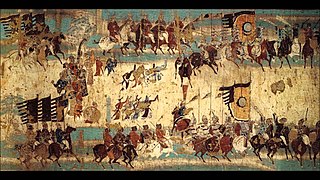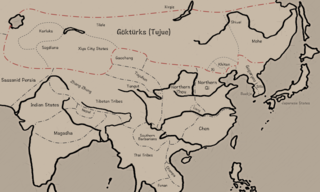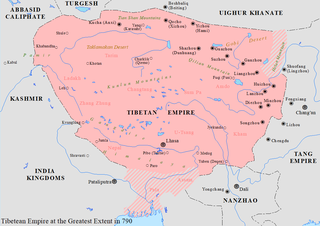
The Battle of Talas was an armed confrontation between the Abbasid Caliphate and the Tibetan Empire against the Tang dynasty in 751 CE. In July of that year, the Tang and Abbasid armies clashed at the Talas River to vie for control over the regions surrounding the Syr Darya. According to Chinese sources, it was initially marked by several days of military stalemate before the balance of power was decisively tipped in the Abbasids' favour due to the defection of a Tang-allied mercenary column, consisting of some 20,000 Qarluq Turks, who subsequently played a vital role in routing the Tang army.

The Kingdom of Khotan was an ancient Buddhist Saka kingdom located on the branch of the Silk Road that ran along the southern edge of the Taklamakan Desert in the Tarim Basin. The ancient capital was originally sited to the west of modern-day Hotan at Yotkan. From the Han dynasty until at least the Tang dynasty it was known in Chinese as Yutian. This largely Buddhist kingdom existed for over a thousand years until it was conquered by the Muslim Kara-Khanid Khanate in 1006, during the Islamization and Turkicization of Xinjiang.

The Tarim Basin is an endorheic basin in Xinjiang, Northwestern China occupying an area of about 888,000 km2 (343,000 sq mi) and one of the largest basins in Northwest China. Located in China's Xinjiang region, it is sometimes used synonymously to refer to the southern half of the province, that is, Southern Xinjiang or Nanjiang, as opposed to the northern half of the province known as Dzungaria or Beijiang. Its northern boundary is the Tian Shan mountain range and its southern boundary is the Kunlun Mountains on the edge of the Tibetan Plateau. The Taklamakan Desert dominates much of the basin. The historical Uyghur name for the Tarim Basin is Altishahr, which means 'six cities' in Uyghur. The region was also called Little Bukhara or Little Bukharia.

Kucha or Kuche was an ancient Buddhist kingdom located on the branch of the Silk Road that ran along the northern edge of what is now the Taklamakan Desert in the Tarim Basin and south of the Muzat River.

The Protectorate of the Western Regions (simplified Chinese: 西域都护府; traditional Chinese: 西域都護府; pinyin: Xīyù Dūhù Fǔ; Wade–Giles: Hsi1-yü4 Tu1-hu4 Fu3) was an imperial administration (a protectorate) situated in the Western Regions administered by Han dynasty China and its successors on and off from 59 or 60 BCE until the end of the Sixteen Kingdoms period in 439. The "Western Regions" refers to areas west of Yumen Pass, especially the Tarim Basin in southern Xinjiang. These areas would later be termed Altishahr (southern Xinjiang, excluding Dzungaria) by Turkic-speaking peoples. The term "western regions" was also used by the Chinese more generally to refer to Central Asia.
The Protectorate General to Pacify the West, initially the Protectorate to Pacify the West, was a protectorate established by the Chinese Tang dynasty in 640 to control the Tarim Basin. The head office was first established at the prefecture of Xi, now known as Turpan, but was later shifted to Qiuci (Kucha) and situated there for most of the period.

The Türgesh or Türgish were a Turkic tribal confederation. Once belonging to the Duolu wing of the Western Turkic On Oq elites, Türgeshes emerged as an independent power after the demise of the Western Turks and established a khaganate in 699. The Türgesh Khaganate lasted until 766 when the Karluks defeated them. Türgesh and Göktürks were related through marriage.

Suyab, also known as Ordukent, was an ancient Silk Road city located some 50 km east from Bishkek, and 8 km west southwest from Tokmok, in the Chu river valley, present-day Kyrgyzstan. The ruins of this city, along with other acheological sites associated with the Silk Road, was inscribed in 2014 on the UNESCO World Heritage List as the Silk Roads: the Routes Network of Chang'an-Tianshan Corridor World Heritage Site.

The Protectorate General to Pacify the North or Grand Protectorate General to Pacify the North (647–784) was a Chinese military government established by the Tang dynasty in 647 to pacify the former territory of Xueyantuo, which extended from Lake Baikal to the north, the Gobi Desert to the south, the Khingan Mountains to the east, and the Altay Mountains to the west. It controlled the Mongolian Plateau from 647 to 682.

The Beiting Protectorate-General, initially the Beiting Protectorate, was a Chinese protectorate established by the Tang dynasty in 702 to control the Beiting region north of Gaochang in contemporary Xinjiang. Wu Zetian set up the Beiting Protectorate in Ting Prefecture and granted it governorship over Yi Prefecture (Hami) and Xi Prefecture (Gaochang). The Beiting Protectorate ended in 790 when Tingzhou was conquered by the Tibetan Empire. The ruins, along with other sites along the Silk Road, were inscribed in 2014 on the UNESCO World Heritage List as the Silk Roads: the Routes Network of Chang'an-Tianshan Corridor World Heritage Site.

The conquest of the Western Turks, known as the Western Tujue in Chinese sources, was a military campaign in 655–657 led by the Tang dynasty generals Su Dingfang and Cheng Zhijie against the Western Turkic Khaganate ruled by Ashina Helu. The Tang campaigns against the Western Turks began in 640 with the annexation of the Tarim Basin oasis state Gaochang, an ally of the Western Turks. Several of the oasis states had once been vassals of the Tang dynasty, but switched their allegiance to the Western Turks when they grew suspicious of the military ambitions of the Tang. Tang expansion into Central Asia continued with the conquest of Karasahr in 644 and Kucha in 648. Cheng Zhijie commanded the first foray against the West Tujue, and in 657 Su Dingfang commanded the main army dispatched against the Western Turks, while the Turkic generals Ashina Mishe and Ashina Buzhen led the side divisions. The Tang troops were reinforced by cavalry supplied by the Uyghurs, a tribe that had been allied with the Tang since their support for the Uyghur revolt against the Xueyantuo. Su Dingfang's army defeated Helu at the battle of Irtysh River.

The Tang campaign against Kucha was a military campaign led by the Tang dynasty general Ashina She'er against the Tarim Basin oasis state of Kucha in Xinjiang, which was aligned with the Western Turkic Khaganate. The campaign began in 648 and ended on 19 January 649, after the surrender of the Kuchan forces following a forty-day siege in Aksu. Kuchean soldiers tried to recapture the kingdom with the assistance of the Western Turkic Khaganate, but were defeated by the Tang army.

The Tang campaigns against the Western Turks, known as the Western Tujue in Chinese sources, were a series of military campaigns conducted by the Tang dynasty against the Western Turkic Khaganate in the 7th century AD. Early military conflicts were a result of the Tang interventions in the rivalry between the Western and Eastern Turks in order to weaken both. Under Emperor Taizong, campaigns were dispatched in the Western Regions against Gaochang in 640, Karasahr in 644 and 648, and Kucha in 648.

The Tang campaigns against Karasahr were two military campaigns sent by Emperor Taizong of the Tang dynasty against the Tarim Basin kingdom of Karasahr, a vassal of the Western Turkic Khaganate. The city-state, which later became part of Xinjiang), may have been known to its inhabitants by the Tocharian name Agni, which was rendered Yanqi in Chinese sources. The first campaign in 644 was led by the Tang commander Guo Xiaoke, protector-general of the Anxi Protectorate in western China, who defeated the oasis state and a Western Turkic army and installed a Tang loyalist as ruler. The second campaign in 648, which was part of the campaign against Karasahr's neighboring state of Kucha, was led by a Turkic general of the Tang dynasty, Ashina She'er, who defeated and conquered Karasahr.

The military of the Tang dynasty was staffed with a large population of Turkic soldiers, referred to as Tujue (突厥) in Chinese sources. Tang elites in northern China were familiar with Turkic culture, a factor that contributed to the Tang acceptance of Turkic recruits. The Tang emperor Taizong adopted the title of "Heavenly Kaghan" and promoted a cosmopolitan empire. Turkic soldiers that served under the Tang dynasty originated from the Eastern Turkic Khaganate. It began with Tang dynasty Emperor Taizong who sent his general Li Jing, eventually ended in defeating the Eastern Turks and capturing their leader Jiali Khan.

The Battle of Aksu was fought between the Umayyad Caliphate, and their Turgesh and Tibetan allies, against the Tang dynasty, and their Karluk and Western Turk allies. In 717 AD, the Umayyads, guided by their Turgesh allies, besieged Buat-ɦuɑn (Aksu) and Dai-dʑiᴇk-dʑiᴇŋ (Uqturpan) in the Aksu region of Xinjiang. Tang troops backed by their protectorates in the region attacked and routed the besieging Umayyads forcing them to retreat.

The Shule Kingdom was an ancient oasis kingdom of the Taklamakan Desert that was on the Northern Silk Road, in the historical Western Regions of what is now Xinjiang in Northwest China. Its capital was Kashgar, the source of Kashgar's water being a river of the same name. Much like the neighboring people of the Kingdom of Khotan, people of Kashgar spoke Saka, one of the Eastern Iranian languages.

This is a timeline of the Tang dynasty, which covers a period of roughly 289 years, from 618, when the dynasty was founded, to 907, when the last Tang emperor was deposed by the warlord Zhu Wen, who established the Later Liang dynasty, inaugurating the period of Five Dynasties and Ten Kingdoms. Information on areas and events relevant to the Tang dynasty such as the Wu interregnum, when Wu Zetian established her own Zhou dynasty, and other realms such as the Sui dynasty, Tibetan Empire, Three Kingdoms of Korea, Nanzhao, Japan and steppe nomads are also included where necessary.

This is a timeline of the Göktürks from the origins of the Turkic Khaganate to the end of the Second Turkic Khaganate.

This is a timeline of the Tibetan Empire from 6th to 9th century.




















